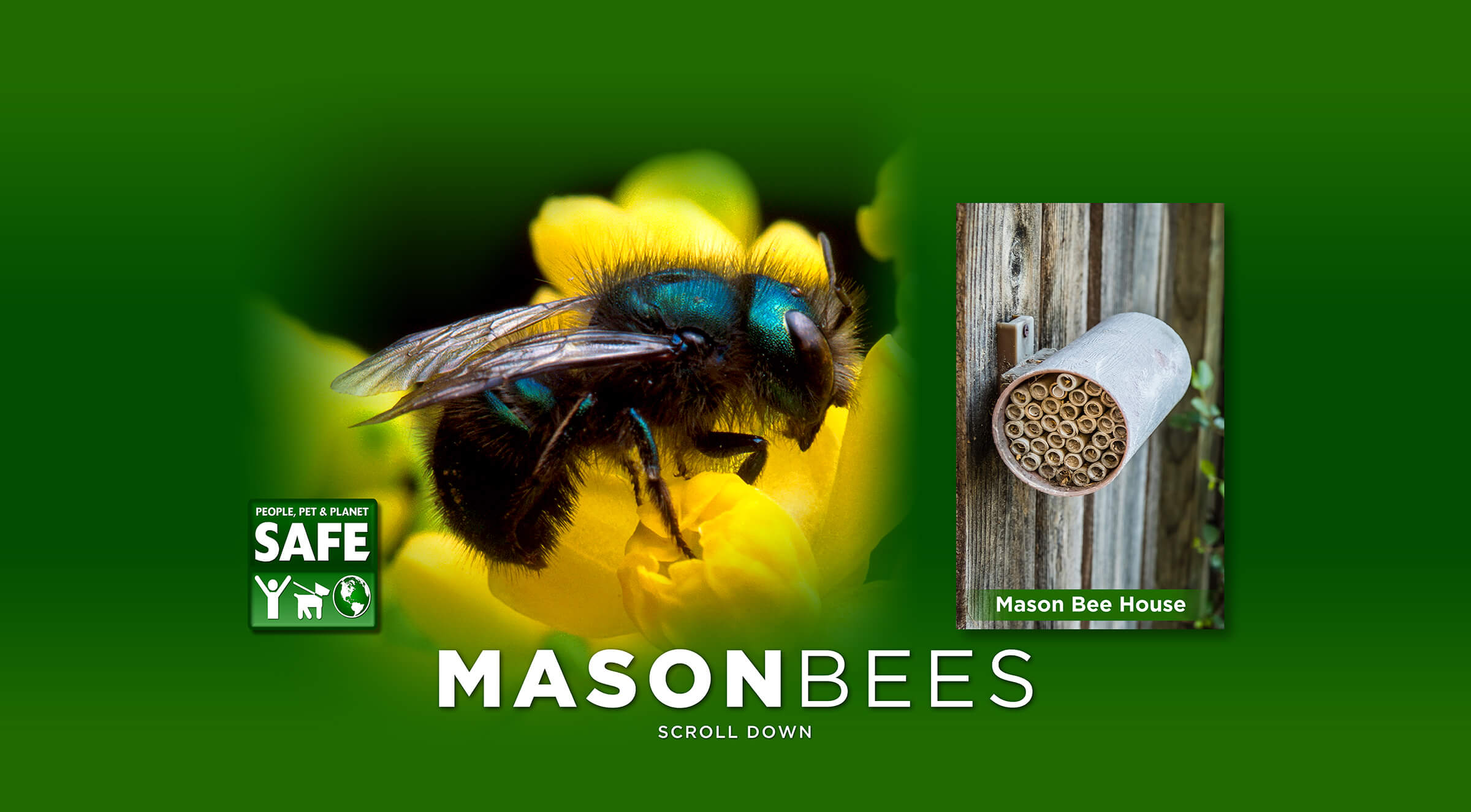THE GENTLE MASON BEE

USE: The Blue Orchard Mason Bee, technically known as Osmia lignaria, is an excellent pollinator. This kit will help attract these beneficial bees to your garden. Since Mason Bees are solitary bees and do not make hives, they are always looking for a place to make a home. They look for a hole or tunnel that has been bored out by a beetle or other insect and go in and clean it out. When they find these tubes that are the perfect size and shape, and already cleaned out, they will move right in.

WHAT ARE MASON BEES?
Mason Bees are found naturally all over North America. There are 402 species that live in the United States. We tend not to notice them because they are dark blue in color and look like large flies. Mason bees are different than honey bees and bumble bees because they do not have a queen, do not make hives, and do not make honey. Because they do not have these things to protect, they normally don’t sting and are safe around children and pets.
These bees are not affected by the mite that has devastated the honey bee population in the United States, and they do not mate with the aggressive African bees that have moved north from South America.
WHAT ARE MASON BEES GOOD FOR?
The benefit of Mason Bees is that they are excellent pollinators, 120 times more effective than honey bees or bumble bees. This is because those bees have a colony to support and carry most of the pollen they collect back to the hive. Mason Bees do not have a hive so all of the pollen they collect stays with them. Plus they are more “scruffy” than honey bees – they have a lot of hair on their bodies and don’t bother to clean it very much – so as they go from flower to flower they pick up lots of pollen and transfer it to more flowers. Mason Bees are also early risers, they emerge in early Spring when temperatures are still cold, long before honey bees become active. This is typically when fruit trees begin to bloom. All this increased pollination will improve the yield on fruit trees and increase the quantity and quality of blooms on flowering plants and herbs.

INSTALLATION: Mason Bees like morning sunshine, so look for a south or east facing spot. A fence or wall or side of a building is good. Avoid a spot under a swaying branch since the bees don’t like dappled shade. Pick a spot well above ground, insert the nest into the mounting bracket, and use the included screws to mount the nest horizontally. Remove the plastic cap to expose the nesting tubes. There are more detailed instructions inside the cylinder, remove these for further reference.
MASON BEE LIFE CYCLE: Mason Bees will normally begin to appear in early spring, usually in March or April depending on location. They mate soon after emerging from their home and immediately begin their search for pollen and nectar. The females will also begin looking for a new home. If she finds a tube or beetle boring that has previously been used, she will first clean it out. If she finds a nester tube, she will use it immediately. She will start by going to the back of the tube and laying an egg, depositing some pollen and nectar for food, and building a wall to create a cell. This wall building is why they are called Mason Bees. She repeats this process about 10 times, creating a cell for each egg. This activity usually continues through June, then they will begin dying. But the eggs are now hatching and eating the food that was left for them. The larvae go through their entire cycle inside each individual cell, molting 4 to 5 times. Around August they will spin a cocoon and begin gradually developing into an adult Mason Bee.
GENERAL MASON BEE INFORMATION:
GENERAL MASON BEE INFORMATION: Mason Bees are often referred to as solitary bees because they do not have a social order like honey bees and bumble bees. They do not have a queen or a hive and they do not make honey. However, they are perfectly happy making a nest right next to each other. Mason Bees are such effective pollinators because they have a lot of hair on their body which picks up pollen. Unlike honeybees which clean themselves after each visit to a flower and lose 90% of the pollen, the Mason Bees carry all of their pollen from flower to flower. Mason Bees tend not to sting because they are not a social bee and do not have a hive or a queen to protect. The only way to get one to sting is to squeeze it, and even then it probably won’t sting. Fortunately Mason Bees are not susceptible to the Varroa mite which has caused such havoc with honey bees all over north America.
Now that you've learned more about mason bees, it's time to add these wonderful insects to your garden. Like all beneficial insects, you can be sure that they'll dine only on your garden's pests and won't harm the good bugs or your plants. Use our dealer locator to find a store near you!
Click above to WATCH A VIDEO with instructions.






